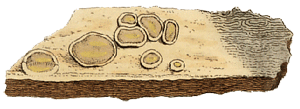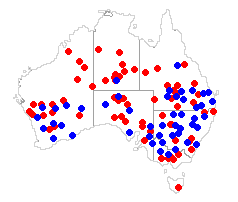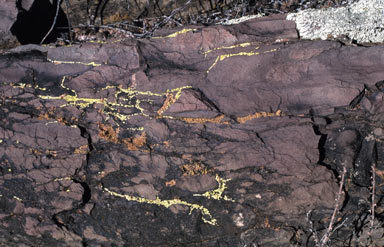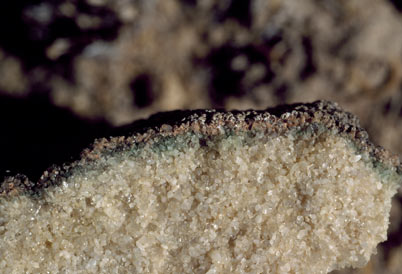 Ecology - Habitats
Ecology - Habitats
Lichens in arid areas
Many species of lichen are found in the world's hot arid areas. Two other pages are also relevant to a discussion of lichens in hot, dry regions. BIOLOGICAL SOIL CRUSTS are soil-inhabiting communities composed of varying mixes of lichens, bryophytes, algae and cyanobacteria and have significant ecological roles in hot, dry habitats. Sand is both a substrate and a challenge to many terrestrial lichens which, in sandy areas may easily be covered by windblown sand grains. Yet lichens do grow on sand, even on sand dunes except those that are highly mobile. Where surfaces are unstable VAGRANT LICHENS can be found, though they are not confined to such habitats.
 Amongst the many lichens in Australia's arid areas are the eye-catching crustose thalli of various species of Caloplaca, from shades of brownish-orange
Amongst the many lichens in Australia's arid areas are the eye-catching crustose thalli of various species of Caloplaca, from shades of brownish-orange ![]() to bright orange
to bright orange ![]() . Large colonies of Xanthoparmelia are also a common sight in many of the rocky arid areas of Australia
. Large colonies of Xanthoparmelia are also a common sight in many of the rocky arid areas of Australia ![]() but can also be found on soil. Many species of this genus are found in Australia's arid areas and there there's more distributional information on the XANTHOPARMELIA page. Many lichen species are confined to arid areas and some are known from very limited areas, whereas others are very widespread. The accompanying map shows the Australian distributions of Acarospora citrina
but can also be found on soil. Many species of this genus are found in Australia's arid areas and there there's more distributional information on the XANTHOPARMELIA page. Many lichen species are confined to arid areas and some are known from very limited areas, whereas others are very widespread. The accompanying map shows the Australian distributions of Acarospora citrina ![]() (red dots) and Heterodea beaugleholei
(red dots) and Heterodea beaugleholei ![]() (blue dots), based on herbarium records. As you can see from the map, they occur also in non-arid Australia and both can be found in urban Canberra. Some other examples of lichens found in arid Australia are Buellia subcoronata
(blue dots), based on herbarium records. As you can see from the map, they occur also in non-arid Australia and both can be found in urban Canberra. Some other examples of lichens found in arid Australia are Buellia subcoronata ![]() , Diploschistes thunbergianus
, Diploschistes thunbergianus ![]() , Endocarpon pusillum
, Endocarpon pusillum ![]() , Haematomma eremaeum
, Haematomma eremaeum ![]() , Heppia despreauxii
, Heppia despreauxii ![]() and Siphula coriacea
and Siphula coriacea ![]() .
.
Before going on it is necessary to state several facts. The dry thalli of many arid area species can survive high temperatures, whereas when wet those thalli would suffer considerable damage at comparable or lower temperatures. Lichens photosynthesize only when hydrated. As a dry lichen thallus rehydrates there is an initial period during which the thallus is using photosynthetic reserves but not yet photosynthesizing. Once the thallus starts photosynthesizing it will take a little while before photosynthesis has replaced the reserves consumed during rehydration and it can then start producing the resources that would allow further growth. Given this 'start-up' cost, it can be more beneficial to have one extended period of photosynthesis than numerous shorter, start-stop photosynthesizing episodes - even if the photosynthesizing times of all the short episodes add up to a considerable total. In many arid areas the early morning dew allows dry thalli to rehydrate and there is then some time available for photosynthesis but as the daytime temperature climbs the thalli would start to dry out and become dormant, to await the next hydrating opportunity. There's some more detail in the HYDRATION & PHOTOSYNTHESIS CASE STUDY.
|
A lichen can do nothing to produce water so it is important that when water does appear its benefits are maximized. One way to do so is for lichens to grow in areas such as rock crevices, amongst boulders or on the soil below shrubs, thereby getting some protection from drying winds and the full force of the sun. In such microhabitats the time available for photosynthesis can be longer than that for a similar lichen that is just a few metres away in a fully exposed location. Some microhabitats, such as rock crevices or similar irregularities, would tend to trap reproductive propagules as well as water runoff (and hold water for longer than smooth rock), so that such areas would favour the establishment of various lichens or other cryptogams. The photo (right) shows yellow 'veins' of Acarospora citrina and brownish-orange 'veins' of a Caloplaca growing along cracks or surface irregularities on rock in semi-arid Australia. On the MICROHABITATS page there is a section about some microhabitats in hot, arid areas.
Water sources & growth forms
In the world's deserts or semi-deserts one obvious challenge is water. Rainfall can be rare and unpredictable but small quantities of water can be fairly common, in either liquid form (as dew, via overnight condensation) or as vapour (via fogs, especially in some coastal deserts). Lichens make effective use of both sources - though not all lichens can exploit water vapour effectively. Many species with algal photobionts are able to utilize moisture from fog but lichens with cyanobacterial photobionts need liquid water in order to rehydrate and commence photosynthesis. Thus, where fog is common but rainfall rare lichens with algal photobionts dominate.
Some growth forms or morphological variations in thallus construction can favour faster uptake of water, whether liquid or vapour. However, there is a problem here since many features which allow faster uptake also allow faster loss. For example, the greater the thallus' surface-area-to-volume ratio the easier it is to gain or lose water and a much-branched fruticose thallus is an excellent example of a thallus with a high ratio. A thin cortex is more conducive to water transfer than a thick cortex and a loosely packed medulla is also conducive to faster transfer. It is obvious that there must be a balancing act to allow sufficiently fast water uptake, but not too easy a loss of water. One important factor that would help determine what sorts of lichens are able to survive in various areas is the form in which water is supplied: rainfall (or runoff), dew or fog.
Uptake of liquid water is very fast. Air-dried thalli of many species can reach 70-100% of saturation levels within 30 seconds when rehydrated with liquid water, with full saturation often in under five minutes. Dehydration is via evaporation from the cortical layers and is always a much slower process than uptake of liquid water. This means that where rainfall or runoff is the major source of water a lichen would benefit more from features that guard against water loss than from those that promote rapid uptake. Thus lichens of compact growth form or with thick cortices would be well-adapted to rainfall or runoff. Sure, if they had thinner cortices or a less compact growth form water uptake would be quicker, but liquid water uptake is fast enough anyway so there is very little to be gained by enhancing it - but a great benefit to be gained by slowing water loss. Crustose lichens, with their low surface-area-to-volume ratios, would be well suited to exploiting rainfall or runoff - especially if they also have thick upper cortices. Where dew is a regular source of water a large horizontal surface area would maximize water gain. Since dew is liquid water, we have another case where features that slow the rate of water loss are the more important. Crustose, foliose and some coarse fruticose thalli could all make use of dew. When compared to uptake of liquid water, water vapour is taken in very slowly - typically at a rate several hundred times slower than that for liquid water. Where fog is the predominant water source enhancement of uptake is vital and this is best done by presenting the incoming fog with a large, vertical surface area - such as that of an upright, finely-branched fruticose thallus.
Lichens in the open would obviously benefit from both direct rainfall and runoff from any higher areas. Runoff can drip from shrubs, be channelled down trunks or flow down angular boulders and a little way around their underside before dripping to the ground. Therefore lichens in microhabitats sheltered by vegetation or suitably shaped boulders could also make use of runoff. To use dew lichens would need to be out in the open, where the dew condenses overnight. Similarly, fog utilization requires thalli to be in the open where they can intercept the incoming fog.
A number of species appear to have different rates of water uptake for upper and lower thallus surfaces, with the rates higher for the latter![]() .
.
Fog deserts
Fogs can occur in arid inland areas but there are various coastal fog deserts where numerous fogs occur each year, are the major source of water and lower the temperature. Depending on winds and topography the effects of such coastal fogs may extend many kilometres inland and, in some locations, produce sufficient moisture to support the growth of vascular plants. An example is the Namib Desert which borders the Atlantic in south-west Africa and is one of the driest areas on earth. It extends north-south for over 1500 kilometres and, in parts, to over 100 kilometres inland. Given the desert's latitudinal range and its varied topography it's not surprising that precipitation also varies depending on location. One general comment is that there is little rain. Average annual rainfall can be as low as seven millimetres in some coastal areas to over 60 millimetres well to the east. However there are coastal fogs with the number of foggy days per year ranging from a few to well over 200 in some parts and fog precipitation varying from very little to at least 160 millimetres per year. The greatest benefits of fog are experienced near the coast but the effects can sometimes be felt well inland. On at least one occasion a desert scorpion has been seen harvesting water from a grass tussock at a research station 60 kilometres inland. The fog was still quite dense at the research station and extended further inland. Fog precipitates on any raised surfaces, such as grass tussocks, shrubs, rocks - and various lichens![]() .
.
Fog precipitation allows a variety of lichens, including various foliose and fruticose species, to grow in many parts of the Namib Desert. This photo (right) shows an abundance of a fruticose Teloschistes species on a Namibian coastal plain. Several Teloschistes species occur in Namibia. All of the red-brown areas in that photo are Teloschistes and here ![]() is a closer view showing Teloschistes and various other lichens. Upright growth coupled with a large surface area is the way to maximize moisture extraction from fog and fruticose species such as Teloschistes are therefore very effective at trapping fog moisture. A crustose thallus growing on a vertical surface facing into the fog would be well-positioned to make use of fog moisture whereas a crustose thallus on the ground would be less efficient at extracting moisture from fog. It is interesting to note that in the northern Namib Desert thalli of some crustose species showed adaptations to fog. Upturned margins were found on thalli of Caloplaca elegantissima and Caloplaca namibensis and a bunched, rather than flat, growth form of Lecidella crystallina was found. Such forms would better intercept and absorb fog moisture than would a totally flat thallus
is a closer view showing Teloschistes and various other lichens. Upright growth coupled with a large surface area is the way to maximize moisture extraction from fog and fruticose species such as Teloschistes are therefore very effective at trapping fog moisture. A crustose thallus growing on a vertical surface facing into the fog would be well-positioned to make use of fog moisture whereas a crustose thallus on the ground would be less efficient at extracting moisture from fog. It is interesting to note that in the northern Namib Desert thalli of some crustose species showed adaptations to fog. Upturned margins were found on thalli of Caloplaca elegantissima and Caloplaca namibensis and a bunched, rather than flat, growth form of Lecidella crystallina was found. Such forms would better intercept and absorb fog moisture than would a totally flat thallus![]() .
.
The coastal deserts of Peru and Chile are also amongst the driest areas of the world. The authors of the paper given in the next reference button described a fog-induced "lichen oasis" found along the highway from Arequipa to Camaná, a coastal town in southern Peru. About 25 kilometres north-east of Camaná and at an altitude of between 950 and 1000 metres there was no phanerogamic vegetation but "...clumps of lichens scattered evenly over about a kilometer of desert". Cloud edges may reach this area and the only source of moisture is what can be trapped from the moving clouds or fogs. The authors added:
The lichen clumps, three decimetres or more in diameter and eight centimetres high, are easily picked up from the ground. Most are of the bright-orange dominant Teloschistes peruensis. A few are the white and black Anaptychia neoleucomelaena f. squarrosa (Vain.) Kurok. Only rarely are these two intermixed in the same clump. On the open clay-soil depressions (i.e. "micro-playas") between the clumps are a number of minute lichens. The most abundant are Buellia auriculata Malme and Solenospora requieni Mass. Other finds included Acarospora chilensis Magn., Caloplaca cirrochroa (Ach.) Th. Fr., a small amount of Collema (possibly C. tenax (Sw.) Ach.), fragments of a very brittle, perforate Ramalina (R. terebrata?), and one tiny thallus of an Usnea
.
Boundary layers
Crustose thalli are common in arid areas. A crustose thallus is raised but little above the surface it is growing on and it is a fact of physics that close to a surface the air is slowly moving. This boundary layer of slowly moving air is a result of the friction between moving air and the surface and there's a little more in the BOUNDARY LAYERS CASE STUDY. It's well known that still or very slowly moving air is a good insulator and it is also the case that molecules (for example, those of water vapour) move slowly through the boundary layer, since diffusion rather than convection is the moving force. Thus water evaporating from a surface is retained for a while within the boundary layer and creates a slightly more humid micro-climate. The thicker the boundary layer the longer the retention time.
It is necessary to consider boundary layer effects when studying the physiology of organisms that live close to surfaces. Such effects are clearly significant for crustose lichens some of which would be wholly within the boundary layer of their substrate, but boundary layer effects also need to be taken into account with foliose and fruticose thalli. Surrounding rocks, twigs, bryophyte colonies or herbaceous plants modify boundary layers, since any roughened surface that increases friction with the air will slow air movement and so increase the thickness of the boundary layer. This also means that of two thalli, otherwise identical except that one is smooth and the other has numerous projections (for example, isidia), the second would have a thicker boundary layer and hence slower loss or uptake of water vapour. Of course, isidia or other projections also increase surface area which could tend to increase the rate of water loss so it is another example of a balancing act.
|
Thalli are protected if they grow immersed in the substrate, for example bark or rock cavities, and there are various crustose species in which all you see above the surface are the spore producing apothecia. Thalli immersed in bark are termed endophloeodic (alternatively endophloeic or endophloedal) and endolithic lichens are those that grow immersed in rock. In this photo (right) of a cryptic lichen you can see the green algal cells quite clearly beneath the surface of a granular rock. While the cavities can trap water and the overlying bark or rock provide some protection against excess heat, the surface's boundary layer also contributes to the survival of the immersed thalli.
Desert types & growth forms
The following table gives some information about thallus forms found in several desert areas. For each area four numbers are given: total number of species and then the percentage breakdown of that total into fruticose, foliose and crustose species. The first part of the table gives information for various inland desert areas. The three sets of numbers for the Sonoran Desert reflect surveys carried out at three different sites within that desert. The second part of the table gives information for two areas of coastal fog desert.
|
No. of species |
% fruticose |
% foliose |
% crustose |
inland deserts |
|
|
|
|
arid South Australia |
42 |
2 |
23 |
75 |
Wakhan, Afghanistan |
82 |
0 |
10 |
90 |
Sahara Desert, Algeria |
114 |
0 |
2 |
98 |
Negev Desert, Israel |
44 |
5 |
2 |
93 |
North and Central Sinai |
51 |
9 |
7 |
84 |
Sonoran Desert, USA
|
17 21 78 |
0 0 0 |
12 19 28 |
88 81 72 |
Chihuahua Desert, USA |
48 |
0 |
40 |
60 |
coastal fog deserts |
|
|
|
|
Baja California, Mexico |
67 |
54 |
13 |
33 |
Cerro Moreno, Chile |
146 |
25 |
14 |
60 |
The table clearly shows the prevalence of crustose forms in inland deserts and a significant number of fruticose species in the fog desert areas. Having said that it is necessary to add that the table is based on data published over 20 years ago so the information would of course be out of date by now. Undoubtedly additional species will have been found in some of those areas and there are likely to have been taxonomic changes. Given these two factors it would be surprising if the percentage breakdowns were not different today. Despite that, the table should still be useful today at least as a qualitative indicator. I don't have proof of this but present the following suggestive argument. It would demand large increases in the numbers of inland fruticose species before they reach significant percentages in those areas. However, fruticose and foliose lichens are more easily spotted than are the crustose species so it seems unlikely that their numbers will have increased greatly. Suppose also that another 200 crustose species had been found in each of Baja California and the Chilean area, with no other changes. Then the fruticose percentages would drop to 13 for the former area and 9 for the latter. Most likely they would still be significantly larger than any new percentages of fruticose lichens in inland deserts, given the likelihood of little change in numbers of inland fruticose species.
Diffusing cones & upside-down thalli
Psora crystallifera is widespread through the dry areas of the world and is found in many parts of Australia. The squamulose thallus has an uneven upper surface ![]() , as if covered with low pyramidal growths. The left hand figure below shows a stylized cross section of part of a thallus. The photobiont layer is shown in green and below that is the medulla. The photobiont layer is composed of vertical chains of photobiont cells and above the photobiont layer is the thick cortex, composed of those pyramids, each of which is about a millimetre or so in height and is formed by a dense mass of colourless hyphae. A little above the photobiont layer is a pigment layer, shown in brown. Intense light can be harmful to a lichen. Within the Psora crystallifera cortex light is diffused within the cones and UV filtered by the pigment layer but sufficient light reaches the photobiont layer to permit effective photosynthesis.
, as if covered with low pyramidal growths. The left hand figure below shows a stylized cross section of part of a thallus. The photobiont layer is shown in green and below that is the medulla. The photobiont layer is composed of vertical chains of photobiont cells and above the photobiont layer is the thick cortex, composed of those pyramids, each of which is about a millimetre or so in height and is formed by a dense mass of colourless hyphae. A little above the photobiont layer is a pigment layer, shown in brown. Intense light can be harmful to a lichen. Within the Psora crystallifera cortex light is diffused within the cones and UV filtered by the pigment layer but sufficient light reaches the photobiont layer to permit effective photosynthesis.

The right hand diagram depicts the way in which a Buellia species has been found growing on quartz rocks in southern Africa. Quartz is translucent and so allows the passage of light rays. Unless a rock is internally homogenous and free of all blemishes, light rays would be refracted at various points. The grey shape represents a translucent quartz rock, partly buried in the brown soil and a lichen, shown in black, is growing on the rock. A refracted light ray, shown in blue, has reached the underside of the lichen thallus and in this case the green photobiont cells are near the thallus-rock boundary. Ordinarily when you see a lichen growing on a pebble you'd find the photobiont layer on the outer thallus surface. In this case the photobiont cells are in a more protected position against the pebble surface and sufficient light still reaches them to allow for effective photosynthesis. Apothecia form on the exposed surface![]() .
.
![An Australian Government Initiative [logo]](/images/austgovt_brown_90px.gif)



